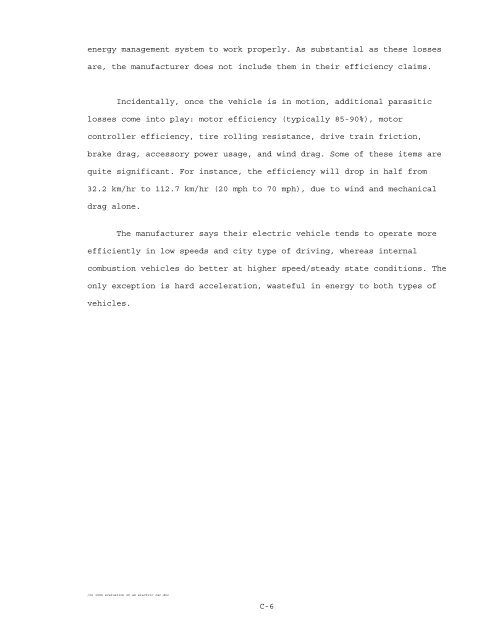Evaluation of Electric Vehicles as an Alternative for Work Trip and ...
Evaluation of Electric Vehicles as an Alternative for Work Trip and ...
Evaluation of Electric Vehicles as an Alternative for Work Trip and ...
Create successful ePaper yourself
Turn your PDF publications into a flip-book with our unique Google optimized e-Paper software.
energy m<strong>an</strong>agement system to work properly. As subst<strong>an</strong>tial <strong>as</strong> these losses<br />
are, the m<strong>an</strong>ufacturer does not include them in their efficiency claims.<br />
Incidentally, once the vehicle is in motion, additional par<strong>as</strong>itic<br />
losses come into play: motor efficiency (typically 85-90%), motor<br />
controller efficiency, tire rolling resist<strong>an</strong>ce, drive train friction,<br />
brake drag, accessory power usage, <strong>an</strong>d wind drag. Some <strong>of</strong> these items are<br />
quite signific<strong>an</strong>t. For inst<strong>an</strong>ce, the efficiency will drop in half from<br />
32.2 km/hr to 112.7 km/hr (20 mph to 70 mph), due to wind <strong>an</strong>d mech<strong>an</strong>ical<br />
drag alone.<br />
The m<strong>an</strong>ufacturer says their electric vehicle tends to operate more<br />
efficiently in low speeds <strong>an</strong>d city type <strong>of</strong> driving, where<strong>as</strong> internal<br />
combustion vehicles do better at higher speed/steady state conditions. The<br />
only exception is hard acceleration, w<strong>as</strong>teful in energy to both types <strong>of</strong><br />
vehicles.<br />
/cu 1996 evaluation <strong>of</strong> <strong>an</strong> electric car.doc<br />
C-6
















